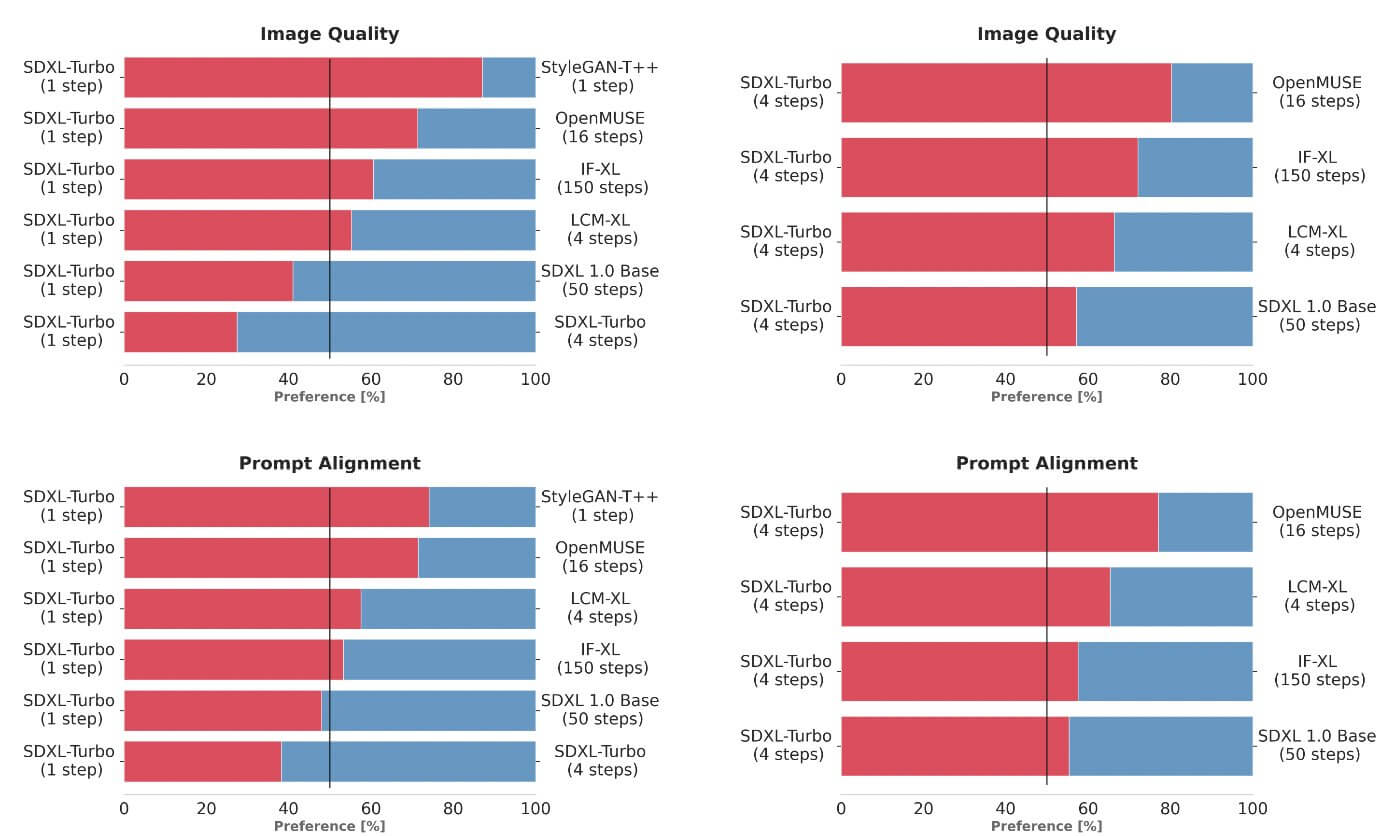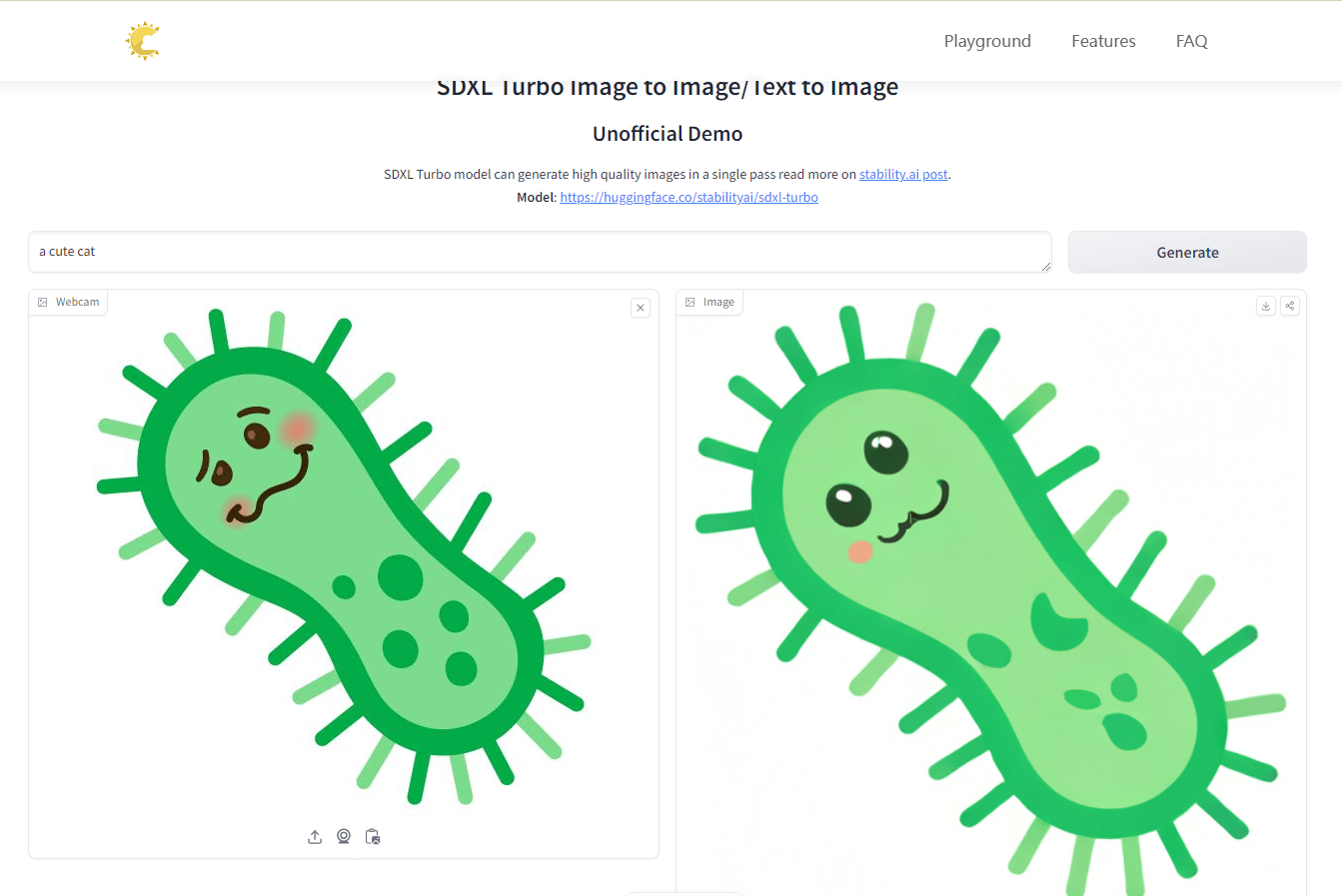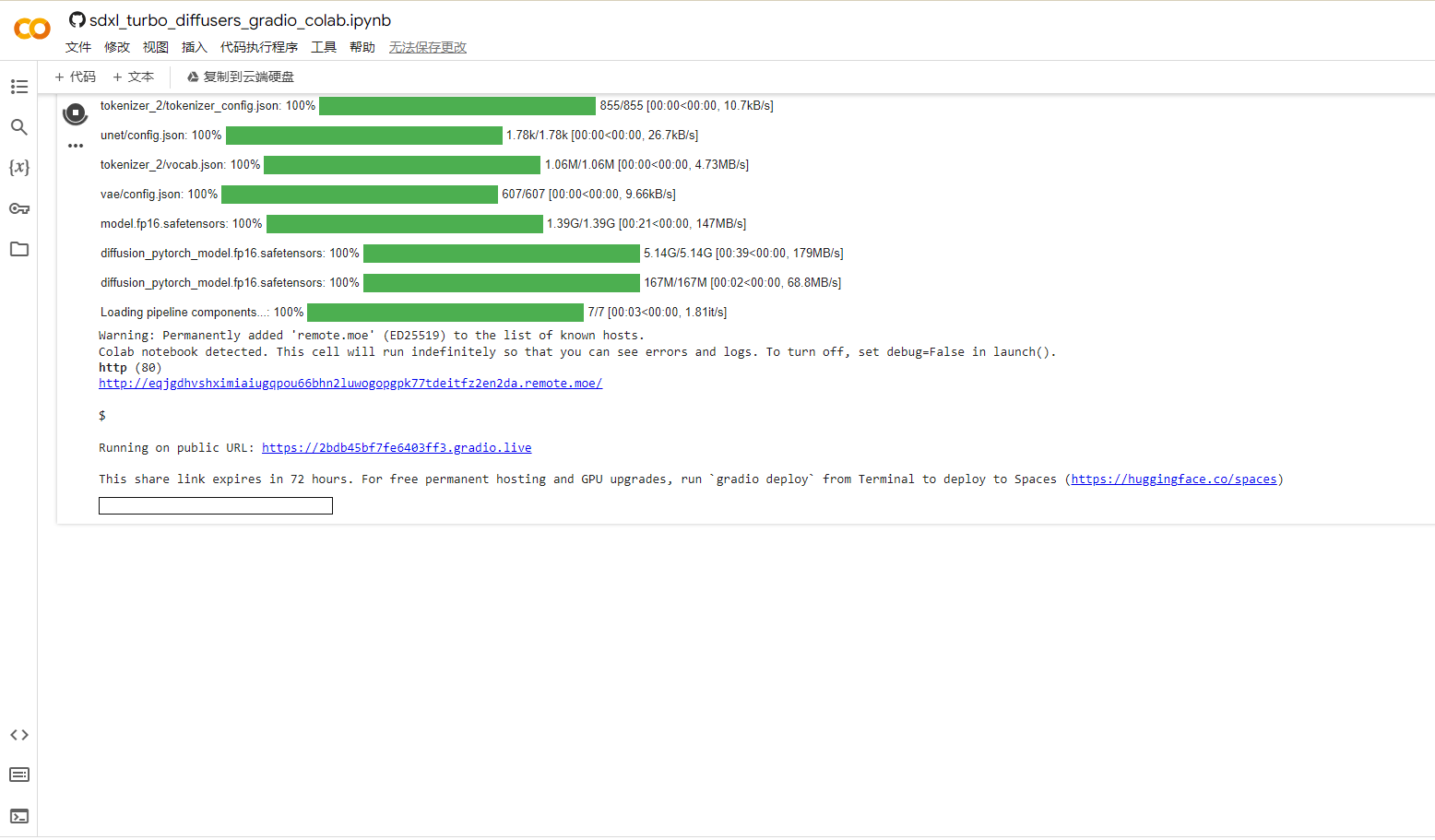SDXL Turbo Online
SDXL Turbo - A Real-Time Text-to-Image Generation Model
SDXL Turbo is based on a novel distillation technique called Adversarial Diffusion Distillation (ADD), which can quickly generate high-quality images.
SDXL Turbo: Power of AI for text-to-image model
SDXL Turbo is an advanced generative text-to-image model that employs Adversarial Diffusion Distillation (ADD) for training.
It is a faster and distilled version of SDXL 1.0, capable of synthesizing high-quality, photorealistic images from a text prompt in just one network evaluation.
SDXL Turbo's key innovation lies in reducing the required step count for image generation from 50 to just one, enabling real-time synthesis with unprecedented image quality.
- Model name
- SDXL Turbo
- Supported OS
- Mac and Windows
- Version
- Latest Version
- Model type
- Generative text-to-image model
- Finetuned from model
- SDXL 1.0 Base
- All Features
- Quickly generate high-quality images
- Lower computational requirements
- Avoidance of Artifacts and Blurriness
- Official GitHub
- https://github.com/Stability-AI/generative-models
- Developers
- Stability AI
- Funded by
- Stability AI
SDXL Turbo Features:
Adversarial Diffusion Distillation (ADD) Advantages.
SDXL Turbo stands out by incorporating the innovative Adversarial Diffusion Distillation (ADD) technique for text-to-image models. This approach not only enables the model to produce single-step image outputs but also shares key advantages with Generative Adversarial Networks (GANs), ensuring high-quality results while effectively avoiding common issues such as artifacts and blurriness often associated with alternative distillation methods.Performance Benefits Compared to Other Diffusion Models.
Building upon the foundation of SDXL 1.0 and integrating advancements in diffusion model technologies, SDXL Turbo excels when compared to various model variants in comprehensive blind tests. In these evaluations, SDXL Turbo surpasses competitors by beating a 4-step configuration of LCM-XL with a single step and outperforming a 50-step configuration of SDXL with only 4 steps. Notably, it achieves this superior performance with significantly reduced computational requirements, demonstrating a remarkable balance between efficiency and image quality.Inference Speed Improvements.
Beyond its exceptional performance in image generation, SDXL Turbo addresses the crucial aspect of inference speed. Notably, on an A100, the model showcases impressive efficiency by generating a 512x512 image in just 207ms. This includes prompt encoding, a single denoising step, and decoding, with a mere 67ms attributed to a single UNet forward evaluation. This emphasis on speed underscores SDXL Turbo's practicality and responsiveness in real-world applications.

How does SDXL Turbo work?
SDXL Turbo operates through the application of Adversarial Diffusion Distillation (ADD), a process wherein a substantial diffusion model undergoes distillation into a more compact UNet model. This refined UNet model is subsequently employed to synthesize images from text embeddings efficiently, all within a single forward pass. The synergy of adversarial training and score distillation within ADD plays a pivotal role in ensuring the model's capability to achieve high-fidelity image generation.
SDXL Turbo resolution
To create an image from text, provide a text prompt. SDXL Turbo typically produces a 512x512 image by default, yielding optimal results. While it's possible to experiment with height and width settings, such as 768x768 or 1024x1024, be aware that adjusting these parameters may lead to a reduction in image quality.
Download SDXL Turbo
The model is available for download on HuggingFace. Click here to download the SDXL Turbo model.
SDXL Turbo Demo
How to Run SDXL Turbo Online?
Step 1. You can enter Prompt directly, and you can also upload pictures for reference.
Step 2. Enter settings
Settings include Strength, Steps and Seed.
Step 3. Generate the image
Press Generate.

Step 4. Save Your Edited Image
How to Run SDXL Turbo with AUTOMATIC1111?
You can use this GUI on Windows or Mac.
Step 1. Download the SDXL Turbo model
Download the SDXL Turbo Model.Find the folder models under stable-diffusion-webui, and finally put the model into the Stable-diffusion folder.
Step 2. Enter settings
On the txt2img page of AUTOMATIC1111, select the sd_xl_turbo_1.0_fp16 model from the Stable Diffusion Checkpoint dropdown menu.
Step 3. Enter Prompt and generate the image
Press Generate.
How to Run SDXL Turbo with ComfyUI?
ComfyUI has official support for the SDXL Turbo model.
Step 1. Update ComfyUI
Step 2. Load the SDXL Turbo workflow
Drag and drop the workflow image file to ComfyUI to load the workflow.
Step 3. Download the SDXL Turbo model
Download the SDXL Turbo Model.Find the folder models under ComfyUI, and finally put the model into the checkpoints folder.
Step 4. Generate an image
Press Queue Prompt.
How to Run SDXL Turbo on Colab?
Run SDXL Turbo simply and quickly on Colab.
Step 1. Open sdxl_turbo_diffusers_colab.ipynb
Open the SDXL Turbo Diffusers.ipynb file and follow the prompts to authorize it.
Step 2. Click the Execute button or use Ctrl+Enter to execute the script
Wait for the script to execute successfully and access the corresponding url address.

Step 3. Visit public URL

Step 4. Enter Prompt and generate the image
Prompt: a close-up picture of a flying pig.

Practical Applications and Limitations
Usage in Various Sectors
SDXL Turbo, with its powerful text-to-image synthesis capabilities, finds diverse applications across industries. It excels in content creation by rapidly generating high-quality visuals for articles, blogs, and social media. In the e-commerce realm, it streamlines product listing by creating compelling images from textual descriptions. Designers and artists benefit from its use in ideation, quickly translating textual concepts into visual representations. SDXL Turbo also plays a pivotal role in advertising, marketing, and gaming by providing eye-catching visuals based on textual prompts. Its utility extends to education, UI/UX design, AI applications, AR/VR experiences, media production, and personalized image creation, making it a versatile tool across a spectrum of creative and functional domains.
Current Limitations
While SDXL Turbo showcases impressive text-to-image synthesis, it does come with certain limitations. The generated images are restricted to a fixed resolution of 512x512 pixels, and although they demonstrate high quality, the model falls short of achieving perfect photorealism. Notably, the model struggles with rendering legible text, posing a challenge for applications requiring textual clarity. Additionally, faces and people, in general, may not be generated with optimal fidelity, impacting the realism of such elements. It's important to acknowledge that the autoencoding aspect of the model introduces a level of loss, contributing to the inherent limitations in the current iteration of SDXL Turbo.
What is the difference between SDXL Turbo and LCM-LoRA?
The comparison between SDXL Turbo and LCM-LoRA reveals distinctions in quality, speed, and flexibility. While SDXL Turbo excels in speed, achieving the fastest generation in just 1 step, its image quality at a resolution of 512x512 pixels may be limiting for certain applications. LCM-LoRA, designed as a universal accelerator for any Stable Diffusion model, offers superior image quality with the capability to generate 1024x1024 images. However, it requires at least 4 steps for generation, making it slower in comparison to SDXL Turbo.
Therefore, the choice between SDXL Turbo and LCM-LoRA depends on the specific requirements of the task at hand, with SDXL Turbo prioritizing speed and LCM-LoRA emphasizing image quality and flexibility.
What is the difference between SDXL Turbo and SDXL 1.0?
SDXL Turbo represents an advancement over its predecessor, SDXL 1.0, which pioneered the field as the first text-to-image model based on diffusion models. The improved version, SDXL Turbo, introduces a novel distillation technique known as Adversarial Diffusion Distillation (ADD). This innovative approach empowers the model to generate images seamlessly in a single step, allowing for real-time text-to-image outputs while upholding a high level of sampling fidelity.
Final Words
In conclusion, SDXL Turbo stands as a remarkable evolution in the realm of text-to-image synthesis, building upon the foundation laid by its predecessor, SDXL 1.0. With the pioneering introduction of Adversarial Diffusion Distillation (ADD), this model sets itself apart as a trailblazer in the field. The ability to generate images in a single step signifies a significant leap forward, enabling real-time text-to-image outputs without compromising on sampling fidelity. While acknowledging its current limitations, particularly in image resolution, SDXL Turbo holds immense promise. Future refinements, potentially through fine-tuning with high-quality images, may further unlock its full potential. As a testament to its speed and efficiency, SDXL Turbo has rightfully earned its place as a noteworthy player in the landscape of text-to-image synthesis models.
SDXL Turbo is Live Now
Frequently asked questions
If you can’t find what you’re looking for, email our support team and if you’re lucky someone will get back to you.
- What is SDXL Turbo?
- SDXL Turbo is based on a novel distillation technique called Adversarial Diffusion Distillation (ADD), which can quickly generate high-quality images.
- How does SDXL Turbo work?
- SDXL Turbo operates through the application of Adversarial Diffusion Distillation (ADD), a process wherein a substantial diffusion model undergoes distillation into a more compact UNet model. This refined UNet model is subsequently employed to synthesize images from text embeddings efficiently, all within a single forward pass. The synergy of adversarial training and score distillation within ADD plays a pivotal role in ensuring the model's capability to achieve high-fidelity image generation.
- Where can I access the SDXL Turbo Online website?
- You can access the SDXL Turbo on https://www.sdxlturbo.top
- How can I download SDXL Turbo?
- The model weights and code for SDXL Turbo are available for download on Hugging Face. Presently, these resources are released under a non-commercial research license, allowing for personal and non-commercial use.
- Who are the authors of SDXL Turbo?
- SDXL Turbo is attributed to a team of authors including Joonho Kim, Jaehoon Lee, Seonghyeon Park, Taesung Kim, Minsu Cho, Sungjin Kim, and Junseok Lee.
- What are some of the main features of SDXL Turbo?
- SDXL Turbo excels in text-to-image synthesis through Adversarial Diffusion Distillation (ADD), enabling single-step outputs with GAN-like advantages. In performance tests, it outperforms competitors, achieving superior results with reduced computational demands. Notably, it surpasses a 4-step LCM-XL configuration with one step and a 50-step SDXL setup with only 4 steps. The model also prioritizes inference speed, generating a 512x512 image in 207ms, showcasing efficiency in real-world applications.
- How to get SDXL Turbo API?
- You can get SDXL Turbo API on Stability AI’s image editing platform Clipdrop.
- What are the applications of SDXL Turbo?
- SDXL Turbo, with its powerful text-to-image synthesis capabilities, finds diverse applications across industries. It excels in content creation by rapidly generating high-quality visuals for articles, blogs, and social media. In the e-commerce realm, it streamlines product listing by creating compelling images from textual descriptions. Designers and artists benefit from its use in ideation, quickly translating textual concepts into visual representations. SDXL Turbo also plays a pivotal role in advertising, marketing, and gaming by providing eye-catching visuals based on textual prompts. Its utility extends to education, UI/UX design, AI applications, AR/VR experiences, media production, and personalized image creation, making it a versatile tool across a spectrum of creative and functional domains.
- What are the limitations of SDXL Turbo?
- The generated images are restricted to a fixed resolution of 512x512 pixels, and although they demonstrate high quality, the model falls short of achieving perfect photorealism. Notably, the model struggles with rendering legible text, posing a challenge for applications requiring textual clarity. Additionally, faces and people, in general, may not be generated with optimal fidelity, impacting the realism of such elements. It's important to acknowledge that the autoencoding aspect of the model introduces a level of loss, contributing to the inherent limitations in the current iteration of SDXL Turbo.